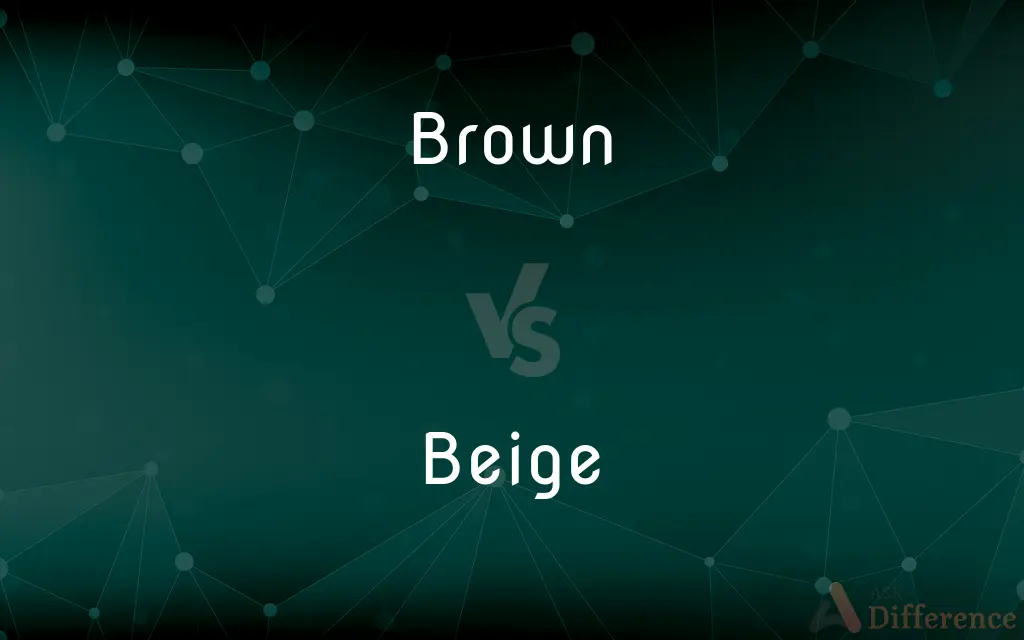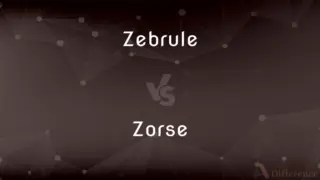Brown vs. Beige — What's the Difference?
By Maham Liaqat & Urooj Arif — Updated on March 11, 2024
Brown is a dark, warm color of high saturation, while beige is a light, neutral color with low saturation.

Difference Between Brown and Beige
Table of Contents
ADVERTISEMENT
Key Differences
Brown is a rich, dark color associated with earth, wood, and stability, often used in design for its warmth and depth. Beige, on the other hand, is a light, neutral color, embodying simplicity and calmness, frequently used in interiors for its versatility and softness.
Brown offers a sense of strength and reliability, making it a favorite in both fashion and interior design for creating grounding and comforting spaces. Whereas beige provides a backdrop of understated elegance and is often used to create a serene and inviting atmosphere, enhancing the sense of space and light.
In terms of color psychology, brown is perceived as solid and dependable, symbolizing resilience and security. Beige, while also associated with reliability, leans more towards flexibility and openness, offering a sense of peace and neutrality.
The versatility of brown allows it to be paired with a wide range of colors for various effects, from earthy and natural to sophisticated and rich. Beige acts as a perfect neutral, complementing brighter colors by providing balance and allowing them to stand out without overwhelming.
The distinction between brown and beige underscores their use in design and color psychology: brown brings warmth and earthiness, conveying stability and strength, while beige offers a clean, minimalistic backdrop, emphasizing lightness and calm.
ADVERTISEMENT
Comparison Chart
Definition
A dark, warm color of high saturation.
A light, neutral color with low saturation.
Associated With
Earth, wood, stability.
Simplicity, calmness.
Color Psychology
Strength, reliability, resilience.
Flexibility, peace, neutrality.
Design Use
Creates grounding, comforting spaces.
Creates serene, inviting atmospheres.
Versatility
Pairs with a wide range of colors.
Acts as a neutral backdrop.
Compare with Definitions
Brown
A rich, dark hue reminiscent of earth and nature.
The brown leather sofa added a touch of elegance to the living room.
Beige
A soft, light color that blends white with a touch of brown.
Beige walls are perfect for making small rooms appear larger.
Brown
Complements both bright and subdued colors, adding richness.
Pairing brown with turquoise creates a vibrant yet grounded look.
Beige
Makes brighter colors pop without competing for attention.
Beige backgrounds allow colorful artwork to stand out beautifully.
Brown
Can vary from light to dark shades, each offering a different ambiance.
Dark brown wood flooring provides a strong foundation for room decor.
Beige
Offers flexibility in design, complementing a wide array of styles.
Beige furniture can easily adapt to various color schemes.
Brown
Emphasizes warmth and depth in designs.
Brown curtains can make a room feel cozy and welcoming.
Beige
Provides a neutral backdrop that enhances natural light.
A beige carpet can brighten a room and make it feel airy.
Brown
Symbolizes stability and reliability.
Brown uniforms are often used by security forces to convey solidity.
Beige
Acts as a base for creating serene and elegant spaces.
A beige living room set creates a calm and welcoming environment.
Brown
Brown is a composite color. In the CMYK color model used in printing or painting, brown is made by combining red, black, and yellow, or red, yellow, and blue.
Beige
Beige is variously described as a pale sandy fawn color, a grayish tan, a light-grayish yellowish brown, or a pale to grayish yellow. It takes its name from French, where the word originally meant natural wool that has been neither bleached nor dyed, hence also the color of natural wool.
Brown
Of a colour produced by mixing red, yellow, and blue, as of dark wood or rich soil
She had warm brown eyes
An old brown coat
Beige
A pale sandy fawn colour
A beige raincoat
Tones of beige and green
Brown
Dark-skinned or suntanned
His face was brown from the sun
Beige
A light grayish brown or yellowish brown to grayish yellow.
Brown
Brown colour or pigment
The brown of his eyes
The print is rich with velvety browns
A pair of boots in brown
Beige
A soft fabric of undyed, unbleached wool.
Brown
A brown thing, in particular the brown ball in snooker.
Beige
Light grayish-brown or yellowish-brown to grayish-yellow.
Brown
A satyrid butterfly, which typically has brown wings with small eyespots.
Beige
A slightly yellowish gray colour, as that of unbleached wool.
Brown
Another term for coloured (sense 2 of the noun)
Beige
Debeige; a kind of woollen or mixed dress goods.
Brown
Make or become brown, typically by cooking
Grill the pizza until the cheese has browned
A skillet in which food has been browned
Beige
Having a slightly yellowish gray colour, as that of unbleached wool.
Brown
Any of a group of colors between red and yellow in hue that are medium to low in lightness and low to moderate in saturation.
Beige
Comfortably dull and unadventurous, in a way that suggests middle-class suburbia.
Brown
Of the color brown.
Beige
Debeige.
Brown
Having a brownish or dark skin color.
Beige
A very light brown
Brown
Often Offensive Of or being a person of nonwhite origin.
Beige
Of a light grayish-brown color
Brown
Deeply suntanned.
Brown
To make or become brown.
Brown
To cook until brown.
Brown
A colour like that of chocolate or coffee.
The browns and greens in this painting give it a nice woodsy feel.
Brown
One of the colour balls used in snooker, with a value of 4 points.
Brown
(uncountable) Black tar heroin.
Brown
A copper coin.
Brown
A brown horse or other animal.
Brown
A person of Latino, Middle Eastern or South Asian descent; a brown-skinned person; someone of mulatto or biracial appearance.
Brown
(entomology) Any of various nymphalid butterflies of subfamily Satyrinae (formerly the family Satyridae).
Brown
(entomology) Any of certain species of nymphalid butterflies of subfamily Satyrinae, such as those of the genera Heteronympha and Melanitis.
Brown
(informal) A brown trout (Salmo trutta).
Brown
A mass of birds or animals that may be indiscriminately fired at.
Brown
Having a brown colour.
Brown
(obsolete) Gloomy.
Brown
(sometimes capitalized) Of or relating to any of various ethnic groups having dark pigmentation of the skin.
Brown
(US) Latino
Brown
(of Asians) South Asian
Brown
(of East Asians) Southeast Asian
Brown
(intransitive) To become brown.
Fry the onions until they brown.
Brown
To cook something until it becomes brown.
Brown
To tan.
Light-skinned people tend to brown when exposed to the sun.
Brown
(transitive) To make brown or dusky.
Brown
(transitive) To give a bright brown colour to, as to gun barrels, by forming a thin coating of oxide on their surface.
Brown
To turn progressively more Hispanic or Latino, in the context of the population of a geographic region.
The browning of America
Brown
Of a dark color, of various shades between black and red or yellow.
Cheeks brown as the oak leaves.
Brown
A dark color inclining to red or yellow, resulting from the mixture of red and black, or of red, black, and yellow; a tawny, dusky hue.
Brown
To make brown or dusky.
A trembling twilight o'er welkin moves,Browns the dim void and darkens deep the groves.
Brown
To make brown by scorching slightly; as, to brown meat or flour.
Brown
To give a bright brown color to, as to gun barrels, by forming a thin coat of oxide on their surface.
Brown
To become brown.
Brown
An orange of low brightness and saturation
Brown
Scottish botanist who first observed the movement of small particles in fluids now known a Brownian motion (1773-1858)
Brown
Abolitionist who was hanged after leading an unsuccessful raid at Harper's Ferry, Virginia (1800-1858)
Brown
A university in Rhode Island
Brown
Fry in a pan until it changes color;
Brown the meat in the pan
Brown
Of a color similar to that of wood or earth
Common Curiosities
What is brown?
Brown is a warm, dark color, often associated with earth, stability, and reliability.
Can brown and beige be used together in design?
Yes, brown and beige can be combined to create a harmonious and balanced aesthetic, capitalizing on their natural compatibility.
Why is brown considered a strong color?
Brown is considered strong due to its association with the earth and nature, conveying a sense of solidity and dependability.
What is beige?
Beige is a light, neutral color, symbolizing simplicity, calmness, and versatility.
Why is beige popular in interior design?
Beige is popular for its ability to create a serene and spacious atmosphere, serving as a versatile backdrop that complements a wide range of decors.
How do brown and beige affect mood?
Brown can evoke feelings of warmth and comfort, whereas beige is known to create a calming and relaxing environment.
Can beige be considered a color in its own right?
Yes, beige is considered a distinct color, offering a unique blend of simplicity and elegance.
Is there a psychological difference in the perception of brown vs. beige?
Psychologically, brown is often associated with strength and resilience, while beige is seen as promoting flexibility and peace.
What role do brown and beige play in sustainable design?
Both colors are frequently used in sustainable designs for their natural and organic qualities, promoting a connection with the environment.
What colors complement brown and beige?
Bright and saturated colors complement brown, while beige pairs well with both bold and pastel hues, serving as a neutral base.
How do brown and beige reflect personal style?
The use of brown can indicate a preference for classic, earthy aesthetics, while beige might reflect a desire for minimalism and lightness.
How should brown and beige be used in seasonal decor?
Brown works well in fall and winter decors for its warm, comforting qualities, while beige is ideal for spring and summer, offering a fresh and airy feel.
Are brown and beige timeless in fashion and design?
Yes, both brown and beige are considered timeless colors, due to their natural origins and wide applicability in various styles and trends.
Can the use of brown and beige influence the perceived size of a space?
Yes, darker shades of brown can make a space feel cozier, while beige can make it appear larger and more open.
How do lighting conditions affect the appearance of brown and beige?
Lighting conditions can significantly affect the appearance of brown and beige, with natural light enhancing their warmth and depth.
Share Your Discovery

Previous Comparison
Zebrule vs. Zorse
Next Comparison
Joist vs. TrimmerAuthor Spotlight
Written by
Maham LiaqatCo-written by
Urooj ArifUrooj is a skilled content writer at Ask Difference, known for her exceptional ability to simplify complex topics into engaging and informative content. With a passion for research and a flair for clear, concise writing, she consistently delivers articles that resonate with our diverse audience.














































